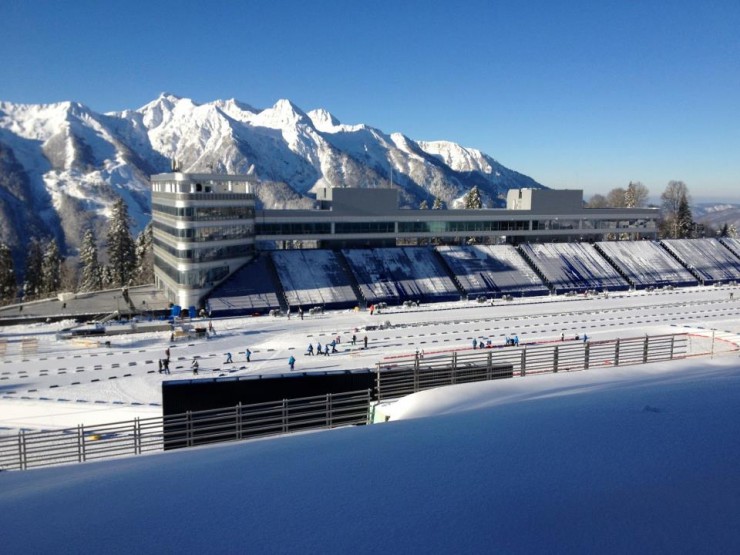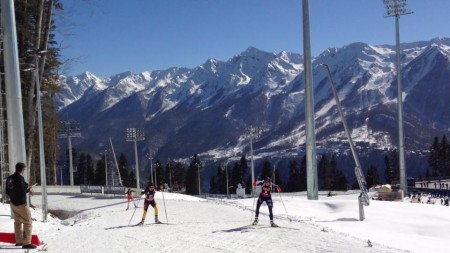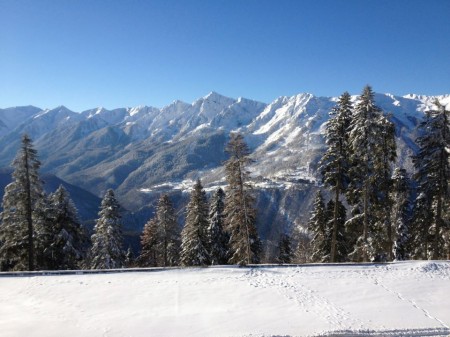
When the biathletes who travel the World Cup circuit arrived in Sochi, Russia, to see their Olympic venue for the first time, they got a preview of what it will be like to compete in Russia.
First the agony: although the chartered flights that carried athletes and equipment from Oslo, Norway, went smoothly, everybody had to wait for several hours in coach buses while the paperwork for their rifles cleared customs. Apparently, the airport hadn’t been prepared for the fact that 200 skiers would be arriving not only with skis, but also with firearms.
“I don’t know exactly what happened, nobody really knows, so that was sort of classic biathlon,” U.S. athlete Susan Dunklee told FasterSkier.
From there it was an hour-long ride up to the athletes’ village, where everyone arrived at about 1:30 in the morning. Surprisingly, that wasn’t as bad as it could have been, and indicated that other things in Sochi were going to go quite well, actually.
“They had hot food waiting for us for dinner at 1:30 in the morning when we arrived, and that was unexpected and awesome,” Dunklee marveled.
And that was before they even got a glimpse of the stadium itself.
Just next to the cross country trails that the FIS skiers previewed last month, the biathlon trails have a similar crushing level of difficulty, especially considering the 1400 meters of elevation. But the stadium goes above and beyond what cross country has to offer, and can house many more spectators and personnel.
“It’s huge,” American Tim Burke told FasterSkier. “That’s what surprised me. The actual stadium, I don’t know what its capacity is, but it looks massive—they definitely spared no expense on the biathlon stadium.”

When athletes tested out the trails in training and in Thursday’s individual races, there was a lot of talk about the difficulty of the trails.
“I assumed they would make a really challenging course because definitely the Russians always seem to like that,” Burke said. “They didn’t do so well today, I think, so who knows. We don’t know who did design the biathlon course, but after today I really wouldn’t be surprised to see them make some changes on the downhill sections—it was bad enough today but I can’t imagine doing that in a mass start with 30 guys coming into those corners, it would be just crazy.”
The toughness of the trails is balanced by a shooting range with a fairly easy approach, which allows athletes to regain composure before they have to shoot down targets. Several athletes noted that most of the field will likely be able to shoot very well, so mistakes will be punished especially harshly come time for the Olympics.
The range itself is built into a hillside and backed by with a 30-meter retaining wall. One more thing that’s not finished? The backdrop, where cement rods still point out of the wall as if athletes are under fire from a bank of guns, not shooting at targets themselves. Dunklee assumed that the whole setup will get a shiny new paint job for the big show.
In the individual races, the field got to preview one set of conditions that they might see at the Olympics: bright sun and hard, fast tracks. That’s what made the downhills so scary, leading to literally dozens of crashes (“It will make a good highlight reel,” Burke said). Biathletes raced with shirt sleeves and sometimes tights rolled up, and a few cramped or overheated in the sun. While it provided a beautiful backdrop, lighting up the steep slopes of the Caucasus mountains across the valley, the sun provided other challenges, too.
“My eyes feel so sensitive to it that I have to wear sunglasses, because if I don’t I feel like my eyes are getting sunburned,” Annelies Cook, who had a career-best finish of 14th in the 15 k, told FasterSkier. “That’s something else to pay attention to, how are your eyes going to deal with that in shooting.”
While the hard-pack conditions made the trails faster, that’s hardly the only type of base biathletes might encounter a year from now when Olympic medals are on the line. In cross country test events, tracks slowed down with heavy snow. Later this week, there’s the possibility of rain. The counterpart to the beautiful sunny weather in Sochi is, often, fog that socks in the venue and could make it tough to even see the targets.
“It was really fast tracks today, with the compact snow and the humidity,” men’s race winner Martin Fourcade of France said in a press conference. “But it’s not going to stay like this all week. I think it’s going to rain, so we will get a lot of conditions here in Sochi, to learn about.”
Luckily, while they’re trying to soak in as much as they can, things are running relatively smoothly around them. Come race time, an army of blue-coated volunteers crops up and ensures that a race is a race, something that athletes can rely on no matter where they are competing.
“It felt like a World Cup,” Dunklee said. “It was professional, and everyone was doing their job the way they were supposed to be doing it. Nothing out of the ordinary there.”
New Habits
The snow is definitely not the only thing that athletes have been checking out this week.

“This whole area is so – it’s beautiful and it’s very strange,” Cook told FasterSkier.
Things just work differently in Russia, and the Americans, at least, appreciated the chance to preview some of the things that might affect how they go about their days at the Olympics. After the rifle kerfuffle at the airport, the guns turned out to be one of the big issues where Sochi is different than venues in other countries.
“They’re really strict,” Burke said. “You can’t have them in the hotel, or the athletes village, you have to keep them there at the venue. That makes it a bit different. A lot of us are used to doing some dry firing in the rooms. There’s lots of extra time needed – you’re never quite sure, with the transport, how long the line’s going to be for people to check out rifles.”
As the cross country skiers noted earlier this season, accreditation is also taken very seriously, and athletes can’t go anywhere without their credentials; it’s a requirement that is not nearly as prevalent at most World Cups or even World Championships.
“I think it’s really good Olympic preparation,” Cook said. “The communication isn’t always that great, and sometimes when you’re taking shuttles places they don’t show up, or it’s kind of a long walk. You have to just feel it out, like, this is how mostly it will be at the Olympics. It shows you what kinds of interesting things you’re going to have to deal with and expect when it gets to be that time.”
For Burke, it’s important to adjust his mental attitude to deal with all these small things.
“You just kind of manage it,” he said. “Here you just kind of have to go with the flow and realize that sometimes things don’t make sense – like, why you have to show your accreditation before you can get into the building with your rifle? I realized I’m not going to change it, I’m along for the ride, so just relax.”
And, luckily, that’s not difficult to do, given the location. You couldn’t ask for better scenery, which is a nice mental boost.
“It’s beautiful here!” Cook gushed. “So gorgeous.”
And the athletes’ village drew universal acclaim. Teams stay in “chalets”, which are spacious and well-designed, with large double rooms that easily beat those of a typical hotel, and lie just ten minutes from the venue. The internet is good, something that racers can’t always rely on. And each chalet has a large common area for relaxing in.
Plus, there’s appliances.
“They put a washing machine in each one, which is worth its weight in gold towards the end of the season here,” Burke laughed. “You hand wash if you can’t find one. So you end up washing your race suit and long underwear in the shower quite a bit.”
No smelly athletes at these Olympics.
It’s a good thing that the scenery is so beautiful and the housing relatively comfortable, because come next year, athletes will be spending a lot of time in this village, which is built for the “endurance” nordic athletes only. With multiple venues ranging from the city itself near the Black Sea to the separate alpine and nordic centers in the mountains, the concept of an “athletes’ village” where the whole Olympic community can come together isn’t something that the Sochi organizers decided to consider.
Of course, that does have some benefits. Up here in the mountains, athletes have a chance to focus and may be able to tune out some of the hoopla that surrounds the biggest winter athletic event in the world.
“I think it’s pretty unique up here where we’re staying,” Burke said. “Really isolated. There’s no road up here. You take a gondola up tot the athlete’s village and there’s really nothing up here besides the venue… for a few weeks during the Games, I think I’ll be spending a lot of time up here.”
-Nat Herz contributed reporting.
Chelsea Little
Chelsea Little is FasterSkier's Editor-At-Large. A former racer at Ford Sayre, Dartmouth College and the Craftsbury Green Racing Project, she is a PhD candidate in aquatic ecology in the @Altermatt_lab at Eawag, the Swiss Federal Institute of Aquatic Science and Technology in Zurich, Switzerland. You can follow her on twitter @ChelskiLittle.



